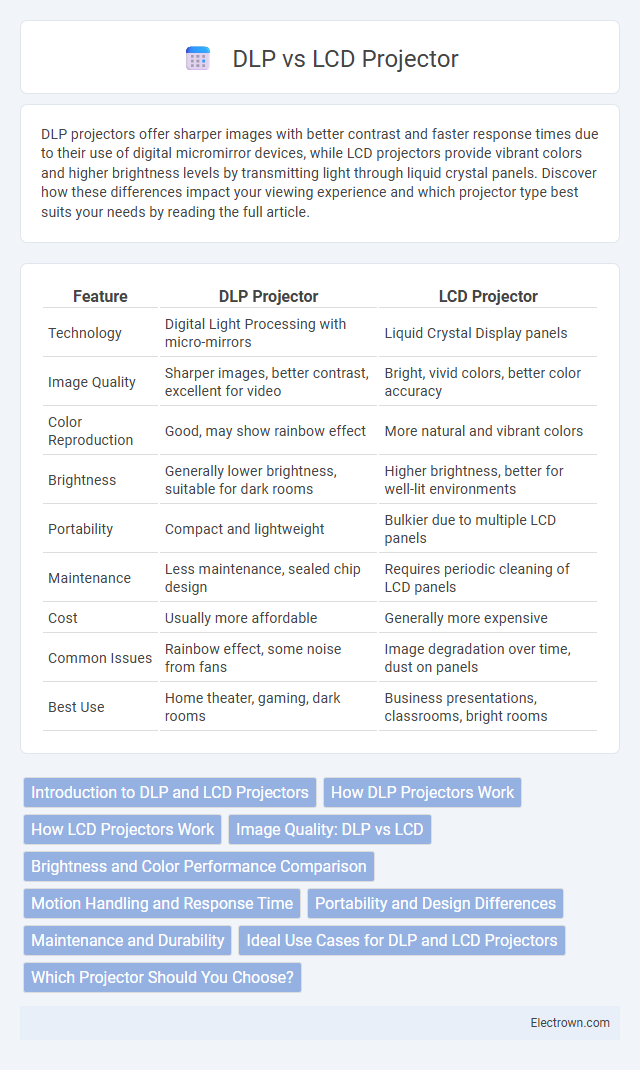DLP projectors offer sharper images with better contrast and faster response times due to their use of digital micromirror devices, while LCD projectors provide vibrant colors and higher brightness levels by transmitting light through liquid crystal panels. Discover how these differences impact your viewing experience and which projector type best suits your needs by reading the full article.
Table of Comparison
| Feature | DLP Projector | LCD Projector |
|---|---|---|
| Technology | Digital Light Processing with micro-mirrors | Liquid Crystal Display panels |
| Image Quality | Sharper images, better contrast, excellent for video | Bright, vivid colors, better color accuracy |
| Color Reproduction | Good, may show rainbow effect | More natural and vibrant colors |
| Brightness | Generally lower brightness, suitable for dark rooms | Higher brightness, better for well-lit environments |
| Portability | Compact and lightweight | Bulkier due to multiple LCD panels |
| Maintenance | Less maintenance, sealed chip design | Requires periodic cleaning of LCD panels |
| Cost | Usually more affordable | Generally more expensive |
| Common Issues | Rainbow effect, some noise from fans | Image degradation over time, dust on panels |
| Best Use | Home theater, gaming, dark rooms | Business presentations, classrooms, bright rooms |
Introduction to DLP and LCD Projectors
DLP (Digital Light Processing) projectors use micro-mirrors to reflect light and create images, delivering sharp contrast and smooth motion for dynamic presentations. LCD (Liquid Crystal Display) projectors project images by passing light through liquid crystal panels, resulting in vibrant colors and crisp image quality with excellent color accuracy. Both technologies cater to different applications, with DLP excelling in fast-moving visuals and LCD favored for static images with rich color detail.
How DLP Projectors Work
DLP projectors use a digital micromirror device (DMD) chip consisting of thousands of tiny mirrors that tilt to direct light and create images. Each mirror corresponds to one pixel, reflecting light through a color wheel or separate color LEDs to produce accurate colors and sharp visuals. This technology allows DLP projectors to deliver smooth motion, high contrast ratios, and minimal rainbow effects compared to LCD projectors.
How LCD Projectors Work
LCD projectors use liquid crystal displays to modulate light and produce images by passing a bright light source through three separate LCD panels--red, green, and blue--that control the color and intensity of each pixel. The light is then combined through a prism to project a sharp, vibrant image onto the screen. Your choice of projector may depend on the accurate color reproduction and brightness that LCD technology typically offers over DLP alternatives.
Image Quality: DLP vs LCD
DLP projectors offer sharper images with higher contrast ratios, making them ideal for environments requiring deep blacks and vivid colors, whereas LCD projectors excel in producing brighter images with more accurate color reproduction and smoother gradients. Your choice depends on whether you prioritize crispness and contrast (DLP) or brightness and color depth (LCD) for your viewing needs. Both technologies deliver high-definition visuals but cater to different aspects of image quality.
Brightness and Color Performance Comparison
DLP projectors typically offer higher brightness levels measured in lumens, making them suitable for well-lit environments, while LCD projectors provide more vibrant and accurate color reproduction due to their distinct liquid crystal panels. Your choice depends on whether you prioritize intense light output or richer color depth, as LCD technology excels in color performance, particularly in saturated hues. For presentations or home theaters, understanding the balance between DLP's brightness advantage and LCD's superior color accuracy is crucial to achieving optimal image quality.
Motion Handling and Response Time
DLP projectors excel in motion handling with faster response times due to their digital micromirror technology, reducing motion blur and providing smoother video playback. LCD projectors may exhibit slower response times and more noticeable motion blur during fast-moving scenes because of liquid crystal shutter delays. For your presentations or gaming needs, a DLP projector typically delivers clearer, sharper motion performance compared to LCD models.
Portability and Design Differences
DLP projectors typically feature a compact, lightweight design that enhances portability, making them ideal for on-the-go presentations and easy storage. LCD projectors tend to be bulkier due to their larger prism and panel components, which may limit mobility but often provide enhanced image color accuracy. Your choice depends on whether portability or visual performance is the priority for your specific needs.
Maintenance and Durability
DLP projectors typically feature fewer moving parts, resulting in lower maintenance requirements and longer durability compared to LCD models. LCD projectors may require periodic filter cleaning and can experience image degradation over time due to panel wear. Choosing a DLP projector can reduce your maintenance efforts and extend the device's lifespan, making it a reliable option for long-term use.
Ideal Use Cases for DLP and LCD Projectors
DLP projectors excel in home theaters and gaming setups due to their smooth motion handling and high contrast ratios, delivering sharp, vibrant images with minimal input lag. LCD projectors are ideal for business presentations and classrooms, offering bright, color-accurate visuals that perform well in well-lit environments. Your choice depends on whether you prioritize color precision and ambient light performance (LCD) or superior contrast and motion clarity (DLP).
Which Projector Should You Choose?
DLP projectors use a digital micromirror device to deliver sharp images with excellent contrast, while LCD projectors rely on liquid crystal panels to produce vibrant colors and brighter displays. Your choice depends on environment and usage: DLP projectors excel in dark rooms with fast-moving images, ideal for movies and gaming, whereas LCD projectors are better suited for well-lit environments like classrooms or meetings. Consider factors such as image quality, ambient light, and portability to decide which projector meets your specific needs.
DLP vs LCD Projector Infographic

 electrown.com
electrown.com